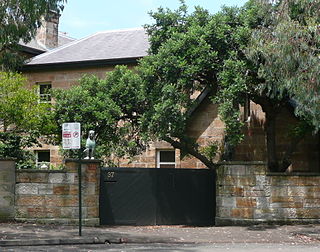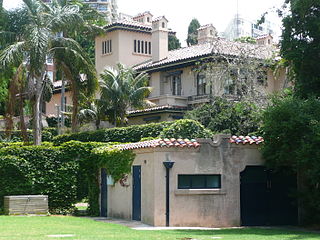
Potts Point is a small and densely populated suburb in inner-city Sydney, New South Wales, Australia. Potts Point is located 2 kilometres (1.2 mi) east of the Sydney central business district and is part of the local government area of the City of Sydney.

Kings Cross is an inner-eastern locality of Sydney, New South Wales, Australia. It is located approximately 2 kilometres east of the Sydney central business district, in the local government area of the City of Sydney. It is bounded by the suburbs of Potts Point, Elizabeth Bay, Rushcutters Bay and Darlinghurst.

Elizabeth Bay House is a heritage-listed Colonial Regency style house and now a museum and grotto, located at 7 Onslow Avenue in the inner eastern Sydney suburb of Elizabeth Bay in the City of Sydney local government area of New South Wales, Australia. The design of the house is attributed to John Verge and John Bibb and was built from 1835 to 1839 by James Hume. The grotto and retaining walls were designed by Verge and the carriage drive on Onslow Avenue was designed by Edward Deas Thomson and built from 1832 to 1835 by convict and free artisans under the direction of Verge. The property is owned by Sydney Living Museums, an agency of the Government of New South Wales. Known as "the finest house in the colony", Elizabeth Bay House was originally surrounded by a 22-hectare (54-acre) garden, and is now situated within a densely populated inner city suburb.

Tresco is a heritage-listed residence located at 97 Elizabeth Bay Road, Elizabeth Bay, City of Sydney, New South Wales, Australia. It was designed by Thomas Rowe and built by Rowe from 1867 to 1883. The property is privately owned. It was added to the New South Wales State Heritage Register on 2 April 1999. The property has previously functioned as a private residence, navy housing, and homestead and was originally indigenous lands. Before 2004 it was owned by the Royal Australian Navy and served as an official residence for the senior naval officers in New South Wales.

The Yaralla Estate, also known as the Dame Eadith Walker Estate and now home to the Dame Eadith Walker Hospital, is a heritage-listed hospital at The Drive, Concord West, City of Canada Bay in Sydney, New South Wales, Australia.

Boomerang is a heritage-listed private house and garden located at 42 Billyard Avenue in the inner eastern Sydney suburb of Elizabeth Bay, New South Wales, Australia. The house was designed by Neville Hampson and the gardens and grounds by Max Shelley, and built from 1926 to 1928.

Victoria Street is a suburban street located in the inner eastern suburbs of Sydney, in the City of Sydney local government area of New South Wales, Australia. From south to north, Victoria Street goes through the suburbs of Darlinghurst, Potts Point and the locality of Kings Cross. It is 1.6 kilometres (0.99 mi) in length. In the section in Darlinghurst, the street is one-way, from north to south only.

Nielsen Park is a heritage-listed historic site, park and nature reserve located at Greycliffe Avenue, Vaucluse in the Municipality of Woollahra local government area of New South Wales, Australia. The traditional lands of the Birrabirragal people, the park was designed by John Frederick Hilly, James Barnet and the Office of the New South Wales Government Architect. It is also known as Vaucluse Estate, Greycliffe Estate and Greycliffe House. It was added to the New South Wales State Heritage Register on 28 August 2017.

St Peter's Anglican Church is a heritage-listed Anglican church located at 187-209 Princes Highway, St Peters, in Sydney, New South Wales, Australia. It is one of the oldest churches in Sydney. Designed by Thomas Bird, the church is sometimes referred to as St Peter's Church, Cooks River, as it is located in the Anglican Parish of Cooks River, New South Wales. The church is listed on the NSW State Heritage Register and on the Register of the National Estate.

The Priory is a heritage-listed former farm, mental health facility, convent and homestead and now building, vacant building and proposed community arts uses at Manning Road, Gladesville in the Municipality of Hunter's Hill local government area of New South Wales, Australia. The main part of The Priory was designed by William Weaver and Henry Hardie Kemp, and built from 1847 to 1874 by Thomas Stubbs, The Marist Fathers in Australia, and Thomas Salter. It is also known as Gladesville Hospital, Gladesville Asylum and The Priory and curtilage. It was added to the New South Wales State Heritage Register on 3 December 2004.

Babworth House is a heritage-listed former residence and school and now staff accommodation at 103 Darling Point Road, Darling Point, Sydney, Australia. It was designed in various stages by Mortimer Lewis, Edmund Blacket, and Morrow and De Putron and built from 1912 to 1915 by Messrs W. Gawne and Son. It is also known as Mount Adelaide. The property is privately owned. It was added to the New South Wales State Heritage Register on 13 August 1999.

Graythwaite is a heritage-listed former private home and former hospital and now school administration building located at 20 Edward Street, North Sydney, New South Wales, Australia. It was designed by Goold and Hilling and Edmund Blacket and built from 1858 to 1885 by Aaron Loveridge. The property is owned by the Sydney Church of England Grammar School. It was added to the New South Wales State Heritage Register on 1 November 2002.

Bomera and Tarana are two jointly heritage-listed residences at 1 Wylde Street in the inner city Sydney suburb of Potts Point, New South Wales, Australia. Bomera was designed by John Frederick Hilly and built in 1856 with alterations by Sheerin & Hennessy and built by Wheelwright & Alderson c. 1902. Tarana was designed by Edward H. Buchanan and built by John Alexander Oag in 1889, with additions including a third storey designed by Sheerin & Hennessy in 1907. The houses are also known as Boomera and Taranah. The property was added to the New South Wales State Heritage Register on 23 June 2000.

Oakleigh is a heritage-listed residence and former boarding house at 18 Ward Avenue in the inner city Sydney suburb of Potts Point in the City of Sydney local government area of New South Wales, Australia. It was built c. 1880 on the former estate of the now-demolished Goderich Lodge. It was added to the New South Wales State Heritage Register on 2 April 1999.

55 Victoria Street is a heritage-listed residence and former boarding house and Catholic Women's Association hostel located in the inner city Sydney suburb of Potts Point, New South Wales, Australia. It was built in 1875. It was added to the New South Wales State Heritage Register on 2 April 1999.

Tusculum is a heritage-listed former residence and now offices at 1–3 Manning Street in the inner city Sydney suburb of Potts Point in the City of Sydney local government area of New South Wales, Australia. It was built from 1831 to 1837 to the design of John Verge for successful businessman Alexander Brodie Spark. It was then let to influential cleric William Broughton, the first and only Anglican Bishop of Australia and later inaugural Bishop of Sydney, from 1836 to 1851. It is owned today by the Historic Houses Trust of New South Wales. It was added to the New South Wales State Heritage Register on 2 April 1999.

Rockwall is a heritage-listed house and former school at 7 Rockwall Crescent in the inner city Sydney suburb of Potts Point in the City of Sydney local government area of New South Wales, Australia. It was designed by John Verge and built from 1831 to 1837. It was added to the New South Wales State Heritage Register on 2 April 1999.

Ashton is a heritage-listed mansion located at 102 Elizabeth Bay Road in the inner eastern Sydney suburb of Elizabeth Bay, New South Wales, Australia. It was designed by Thomas Rowe and built from 1874 to 1875. It is also known as Ashton and its grounds and Caprera (c.1875–c.1910); Brema or Braemar (c.1910–c.1920); The German Consulate.a The property is privately owned. It was added to the New South Wales State Heritage Register on 19 November 2003.

Jobbins Terrace is a series of heritage-listed terrace houses now repurposed as residences and offices located at 103–111 Gloucester Street, in the inner city Sydney suburb of The Rocks in the City of Sydney local government area of New South Wales, Australia. It was built from 1855 to 1857. It is also known as Longs Lane Terraces/Precinct . The property is owned by Property NSW, an agency of the Government of New South Wales. It was added to the New South Wales State Heritage Register on 10 May 2002.

Metropolitan Hotel is a heritage-listed hotel at 244 George Street, Sydney, Australia. It was added to the New South Wales State Heritage Register on 2 April 1999.






















